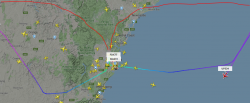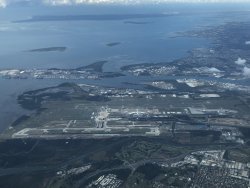When a depressurisation occurs, what is the procedure for pilots (and crew) to don their oxygen masks? There would obviously be a lot going on at that instant.
Is mask-fitting quick and do you need to pre-adjust the mask for fit before flight? Are there issues if you wear spectacles?
The mask and googles come as one piece, and are stowed right next to the seats. They are hidden below the oxygen control panel, with two tabs protruding. You squeeze the tabs and pull, and the mask lifts out of the container. The straps use the oxygen/air mix to tighten, and they remain flaccid until you release the tabs, at which point it behaves like a ‘face hugger’ from the movie Alien. Your glasses stay on, and with a little care, the mask/goggles fit over them. Fitting is extremely quick....a couple of seconds. No adjustment is required at any point.
This is the system QF use in all of their aircraft.
Oxygen Systems
Procedurally, the depressurisation checklist will have you don the mask, ensure you have comms, and then initiate a descent. Once you start that procedure, it contains no fault finding, or attempts to correct the issue. You can do that either established in the descent, or preferably, when level.
The sim exercises for these morphed over the years. From about 1990 they were always flown with the autopilot engaged, and no consideration was given to dropping the landing gear. Dropping the gear did not help at high levels, which is why it was omitted. Most of the exercises involved some sort of failure of the pressurisation system, so the rate of climb wasn’t necessarily all that fast. That sometimes gave a few seconds to try to control it before jumping to the checklist, or alternatively, it might let you get below 14,000’ before the cabin masks would trip. QF30, was, of course, different. The autopilot failed immediately, and the cabin rate of climb was huge (about 25,000 in 13 or so seconds). Not only were there lots of seemingly random failures, but the #3 engine was in very close proximity to the event, and did get some minor FOD. So, sim exercises then started randomly taking the autopilot away, and sliding in either an engine failure or fire into the mix.
















